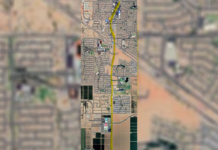
The Maricopa City Council is facing an important decision about what kind of regional organization it wants to join.
Once Maricopa reaches a population of 50,000, if it does not voluntarily join a regional organization, the governor will assign the city to one. According to 2011 U.S. Census Bureau estimates, the city has 44,396 residents.
Council members, though differing on which of the two organizations presented during a Dec. 4 work session would best serve the city, agreed they wanted to choose for themselves.
The city was invited to become part of the Municipal Planning Organization, a transportation policy-making body spearheaded by the city of Casa Grande.
“It could become just an MPO of Casa Grande, but if you look at the transportation needs of Pinal County, it sure made sense to cover as many cities as possible,” Benjamin Bitter, senior analyst for Case Grande said.
He said Casa Grande had approached “every other city in western Pinal County,” including Florence, Apache Junction and Eloy, to build the organization.
Vice Mayor Ed Farrell made it clear he was miffed that Maricopa was the last city to be approached.
Bitter said Casa Grande, having reached a population of 50,000 and being designated as an “urbanized area,” had to become part of a regional organization.
“We didn’t have a choice,” Bitter said. “If we didn’t become an MPO, we would’ve lost any federal funding in the area and also (the Arizona Department of Transportation) would lose its federal funding, they couldn’t spend any federal funds in the area.”
Bitter explained that, provided the staff was kept “lean,” the planning organization could be run using only funds allocated by ADOT.
The planning organization group’s presentation was followed by an offer from the Maricopa Association of Governments to join its coalition, which is one of six councils of governments in the state.
The older and larger group is comprised of 25 cities and towns and three Native American communities.
With many committees – including a transportation policy committee, committee for the homeless, water quality committee, and even an ad hoc elderly and persons with disabilities committee – the entity focuses on regional issues and long-term planning.
Dennis Smith, executive director, listed among the association’s achievements starting the 911 system in Maricopa County, establishing the primary building codes and guidelines used by contractors statewide, known informally as “MAG specs.”
Smith said portions of Pinal County recently had been designated nonattainment areas, meaning the air quality has too much (PM10) particulate matter, an issue MAG has resources in.
“What I could offer is, if you were a member of MAG, we do have just a tremendous air-quality staff and if there was an issue with one of your transportation projects or with the budget setting at (the Arizona Department of Environmental Quality), we could definitely assist you with ADEQ,” Smith said.
“We understand those emissions budgets better than any agency and how to develop those in order for projects to fit,” Smith said.
The cost of joining the government association would depend on what programs the city wants to be involved in.
Eric Anderson, MAG transportation director, said for a city of 50,000 people, it would cost about $8,500 a year for Maricopa to join.
A very lengthy discussion among the council members ultimately lead to the majority of them “leaning towards MAG,” as Mayor Christian Price put it.
Councilman Marvin Brown, however, cautioned against being dazzled by all MAG had to offer.
Brown warned that, should Maricopa join the large group, Maricopa would be “a very small city, thrown in with some very big sharks.”
“I really don’t think we should be so easily swiped away from our sister cities,” Brown said.


![Carl’s Jr plans to “open soon” An exterior view of the new Carl's Jr. restaurant along John Wayne Parkway on May 7, 2024. [Elias Weiss]](https://www.inmaricopa.com/wp-content/uploads/2024/05/E1C66482-CB4C-4FD0-BA30-35CECE93F4BE-218x150.jpeg)
![Filiberto’s eyes building Maricopa restaurant An exterior view of a Filiberto's Mexican Food restaurant at an unknown location and date. [Jessica Boehm/Axios]](https://www.inmaricopa.com/wp-content/uploads/2024/05/axios-050724-filibertos-screenshot-e1715117410101-218x150.jpg)
![SR 238 closures start tomorrow SR 238 [File]](https://www.inmaricopa.com/wp-content/uploads/2022/04/az-238_e_seq_034-218x150.jpg)




![In mayoral race, it’s the Nancy Smith show Maricopa Chamber of Commerce Executive Director Kelly Anderson grills incumbent Mayor Nancy Smith in election's first campaign event April 30, 2024, at Southern Dunes Golf Club. [Elias Weiss]](https://www.inmaricopa.com/wp-content/uploads/2024/04/CRM_1009-218x150.jpg)




![Carl’s Jr plans to “open soon” An exterior view of the new Carl's Jr. restaurant along John Wayne Parkway on May 7, 2024. [Elias Weiss]](https://www.inmaricopa.com/wp-content/uploads/2024/05/E1C66482-CB4C-4FD0-BA30-35CECE93F4BE-100x70.jpeg)

![Filiberto’s eyes building Maricopa restaurant An exterior view of a Filiberto's Mexican Food restaurant at an unknown location and date. [Jessica Boehm/Axios]](https://www.inmaricopa.com/wp-content/uploads/2024/05/axios-050724-filibertos-screenshot-e1715117410101-100x70.jpg)